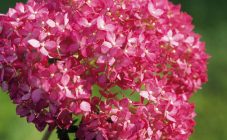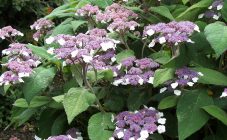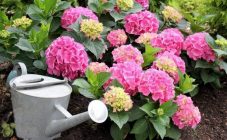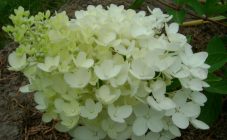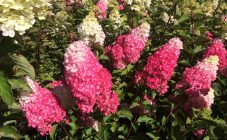Content:
Hydrangea tree Hayes Starburst — it is a beautifully flowering, unpretentious, frost-resistant plant. The culture has characteristic double flowers, formed into irregular inflorescences. At the beginning of flowering, they are greenish, and by the end of July they acquire creamy white shades.
The southeastern United States is considered the birthplace of the Starburst hydrangea. In the natural environment, it grows in the southern and eastern territories of Asia, as well as in the north of the United States. But most of all, the tree hydrangea is widespread in Japan and China.
In addition to the fact that the author of the variety is called H. Jackson, who lived in Anniston, Alabama, nothing more is known about the history of the origin of the Hayes Starburst hydrangea.
Description of the variety
The main characteristics of the variety:
- Hydrangea Starburst is a bush with a height of 1 to 3 m. Its crown is rounded (diameter 140 - 150 cm). At the ends of the shoots there are lush inflorescences (diameter 15 - 25 cm). They can have spherical, hemispherical, flat pyramidal shapes.
- The leaves are large (length 6 - 20 cm), oblong, elliptical, ovoid. They have pronounced serrated edges, heart-shaped bases. The upper sides of the leaf plates are dark green, the lower ones are bare, gray-gray. In the middle of autumn, the leaves acquire a lemon-green color.
- Stems are erect, not very strong, can bend under the weight of flower caps. They need a garter or circular supports. This is considered a disadvantage of the variety.
- Flowers are sterile (small amount) (diameter 2 cm) and small. When they bloom, the petals are greenish. Later they become snow-white, milky with a slight greenness, which disappears by the end of flowering, and the flowers themselves turn slightly pink.
- Terry hydrangea fruits are ribbed brown bolls (size 3 mm). Formed in early autumn.
- The bushes grow quickly (the growth is up to 0.5 m per season). 3 years after planting, the seedling turns into a lush flowering plant.
- Hydrangea Hayes Starburst blooms profusely, for a long time (from June to the very frost).
- Hayes Starburst hydrangea is characterized by high winter hardiness (withstands temperatures down to -35 ° C). It can be grown in almost all territories of the western part of Russia, as well as in the southern regions of Siberia, on Sakhalin.
- The plant loves moisture, is distinguished by its exactingness to the soil, tolerates calcareous soils.
Landing on the site
Planting time depends on the region (local climate).
- In the northern regions, hydrangea tree-like is planted in early spring before sap flow begins, after thawing of the earth. If the region has mild, warm climatic conditions, you can plant plants until the buds swell or in the fall, when the leaves fall off.
- For a plant, you should choose a sufficiently illuminated area (in the morning), well protected from winds and drafts. From lunchtime he should be in partial shade. The eastern, northeastern side of the garden is best suited not far from buildings, fences, trees. Although hydrangea is photophilous, it does not like the bright burning sun.
- Terry hydrangea prefers light, fertile, rich, slightly acidic, moist, well-drained soils (pH 5.5).
- It is best to choose seedlings that are at least 3-4 years old.It is desirable that they have closed roots. Before planting the bushes. they are taken out of the containers, the roots are shortened (by 20 - 25 cm), and dry, damaged roots are removed.
Landing technology:
- The planting hole is dug 65 - 70 cm deep, 50 cm wide, if the soil is poor. If the soil is fertile, you can make the hole height less (60 cm). In any case, it depends on what kind of root system the bush has.
- The pit is filled with a mixture of black soil, humus, peat, sand (2: 2: 1: 1). Mineral fertilizer is added (superphosphate 50 - 60 g, potassium sulfate 30 - 40 g).
- The nutrient soil is poured in a slide. They put a seedling on it, straighten the roots. The root collar is not buried, leaving it at the soil level. They cover it with earth, tamp it, water the bush abundantly at the root and mulch it with peat, compost, needles, sawdust.
Further care
No super-efforts are required here. It's pretty simple.
- Water the Starburst hydrangea regularly (2 times a week), abundantly (at least 3 - 4 buckets of water are poured under each bush). It is desirable that the water temperature is 20-25 ° C. Do not allow the soil to dry out. This will negatively affect the appearance of the plants.
- After irrigation, the trunks are loosened, weeds are weeded (once every 10 days), and mulched. Since the roots of hydrangea are superficial, loosening should not be carried out deeply (within 5 - 6 cm).
- The first couple of years, a young seedling does not need feeding. For 3 years in early spring, urea (20 - 25 g per 10 l of water), superphosphate (30 - 40 g), potassium sulfate (30 - 35 g), nitrogen (20 g per 1 bucket of water) are added under the bushes. During the budding period, nitroammophos is also added to them.
- During the summer, you can use the infusion of mullein, chicken droppings, herbs every month. It is best to alternate organic and mineral fertilizers. In August, they stop feeding hydrangeas with nitrogen substances and use potassium-phosphorus compositions. To strengthen the shoots, the bushes are irrigated with a light pink solution of potassium permanganate.
- During the first 4 years after planting, the bushes are not pruned. Then pruning is carried out 2 times a year. In the spring, the procedure must be carried out before the start of sap flow. Sick, weak, dry, frozen, damaged branches are removed. In autumn, wilted inflorescences are removed, too dense bushes are thinned out. The shoots that have grown over a year are reduced by 3 - 5 buds. Once every 5 - 7 years, shrubs are rejuvenated. The processes are cut off by 10 cm.
- In the autumn in the southern regions, young seedlings are mulched with dry leaves for the first couple of years, and they are covered with earth. If the hydrangea is grown in cold areas, similar procedures are carried out annually. They can also be covered with spruce branches, wrapped with covering material. In winter, the branches of the shrubs must be tied together, bending them to the ground. So they will not break under the weight of the snow cover.
Diseases and pests
Tree hydrangea can be affected by various diseases, be attacked by insects, such as:
- Powdery mildew. Fungicides are used against it, for example, foundationol, topaz, bayleton, quadris.
- Oversporosis (false dew) is destroyed by biofungicides: phytosporin, alirin-B, gamair.
- Chlorosis. The cause of the disease is considered to be an excess of humus, a lack of iron in the soil. To eliminate it, the earth is watered with a solution of iron sulfate.
- From spider mites, leaf aphids, plants are treated with a solution of acaricide, as well as phyto-ferm preparations, actellik, actar, sunmight.
All formulations are prepared according to the instructions attached to them.
Use in landscape design
Treelike hydrangea decorates parks, gardens, squares, streets.It is grown in country houses, in summer cottages. It goes well with conifers, daylilies, phlox, astilbe, geranium. It can be used as a hedge. Hayes Starburst hydrangea also looks great in a single planting against the backdrop of a lawn, as well as various group compositions.
The beauty of the tree hydrangea is undeniable. It can delight with its flowering for many years. In addition, the care does not require something unusual.


